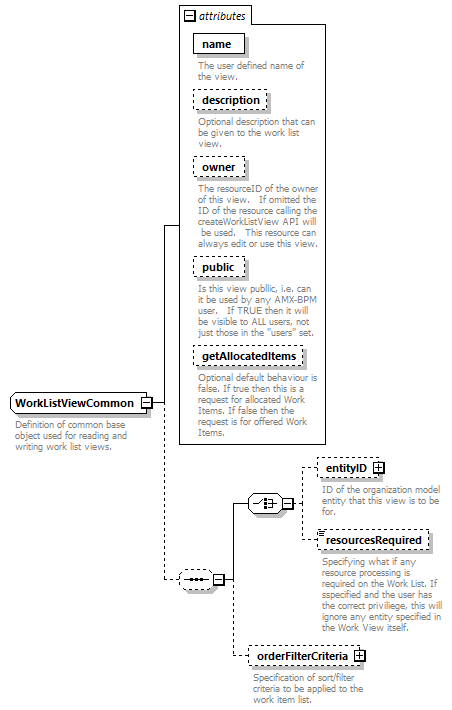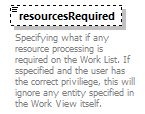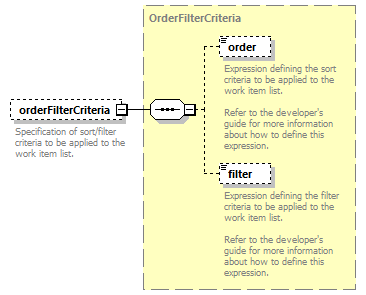| diagram |  |
||||||||||||||||||||||||||||||||||||||||||||||
| namespace | http://api.brm.n2.tibco.com | ||||||||||||||||||||||||||||||||||||||||||||||
| children | entityID resourcesRequired orderFilterCriteria | ||||||||||||||||||||||||||||||||||||||||||||||
| attributes |
|
||||||||||||||||||||||||||||||||||||||||||||||
| annotation |
|
||||||||||||||||||||||||||||||||||||||||||||||
| source | <xs:complexType name="WorkListViewCommon"> <xs:annotation> <xs:documentation>Definition of common base object used for reading and writing work list views.</xs:documentation> </xs:annotation> <xs:sequence minOccurs="0"> <xs:choice> <xs:element name="entityID" type="orgdto:XmlModelEntityId" minOccurs="0"> <xs:annotation> <xs:documentation>ID of the organization model entity that this view is to be for.</xs:documentation> </xs:annotation> </xs:element> <xs:element name="resourcesRequired" type="ResourcesRequiredType" minOccurs="0"> <xs:annotation> <xs:documentation>Specifying what if any resource processing is required on the Work List. If sspecified and the user has the correct priviliege, this will ignore any entity specified in the Work View itself.</xs:documentation> </xs:annotation> </xs:element> </xs:choice> <xs:element name="orderFilterCriteria" type="OrderFilterCriteria" minOccurs="0"> <xs:annotation> <xs:documentation>Specification of sort/filter criteria to be applied to the work item list.</xs:documentation> </xs:annotation> </xs:element> </xs:sequence> <xs:attribute name="name" use="required"> <xs:annotation> <xs:documentation>The user defined name of the view.</xs:documentation> </xs:annotation> <xs:simpleType> <xs:restriction base="xs:string"> <xs:maxLength value="64"/> </xs:restriction> </xs:simpleType> </xs:attribute> <xs:attribute name="description"> <xs:annotation> <xs:documentation>Optional description that can be given to the work list view.</xs:documentation> </xs:annotation> <xs:simpleType> <xs:restriction base="xs:string"> <xs:maxLength value="255"/> </xs:restriction> </xs:simpleType> </xs:attribute> <xs:attribute name="owner"> <xs:annotation> <xs:documentation>The resourceID of the owner of this view. If omitted the ID of the resource calling the createWorkListView API will be used. This resource can always edit or use this view.</xs:documentation> </xs:annotation> <xs:simpleType> <xs:restriction base="xs:string"> <xs:maxLength value="36"/> </xs:restriction> </xs:simpleType> </xs:attribute> <xs:attribute name="public" type="xs:boolean"> <xs:annotation> <xs:documentation>Is this view publlic, i.e. can it be used by any AMX-BPM user. If TRUE then it will be visible to ALL users, not just those in the "users" set.</xs:documentation> </xs:annotation> </xs:attribute> <xs:attribute name="getAllocatedItems" type="xs:boolean"> <xs:annotation> <xs:documentation>Optional default behaviour is false. If true then this is a request for allocated Work Items. If false then the request is for offered Work Items.</xs:documentation> </xs:annotation> </xs:attribute> </xs:complexType> |
attribute WorkListViewCommon/@name
| type | restriction of xs:string | ||||||
| properties |
|
||||||
| facets |
|
||||||
| annotation |
|
||||||
| source | <xs:attribute name="name" use="required"> <xs:annotation> <xs:documentation>The user defined name of the view.</xs:documentation> </xs:annotation> <xs:simpleType> <xs:restriction base="xs:string"> <xs:maxLength value="64"/> </xs:restriction> </xs:simpleType> </xs:attribute> |
attribute WorkListViewCommon/@description
| type | restriction of xs:string | ||||||
| facets |
|
||||||
| annotation |
|
||||||
| source | <xs:attribute name="description"> <xs:annotation> <xs:documentation>Optional description that can be given to the work list view.</xs:documentation> </xs:annotation> <xs:simpleType> <xs:restriction base="xs:string"> <xs:maxLength value="255"/> </xs:restriction> </xs:simpleType> </xs:attribute> |
attribute WorkListViewCommon/@owner
| type | restriction of xs:string | ||||||
| facets |
|
||||||
| annotation |
|
||||||
| source | <xs:attribute name="owner"> <xs:annotation> <xs:documentation>The resourceID of the owner of this view. If omitted the ID of the resource calling the createWorkListView API will be used. This resource can always edit or use this view.</xs:documentation> </xs:annotation> <xs:simpleType> <xs:restriction base="xs:string"> <xs:maxLength value="36"/> </xs:restriction> </xs:simpleType> </xs:attribute> |
attribute WorkListViewCommon/@public
| type | xs:boolean | ||
| annotation |
|
||
| source | <xs:attribute name="public" type="xs:boolean"> <xs:annotation> <xs:documentation>Is this view publlic, i.e. can it be used by any AMX-BPM user. If TRUE then it will be visible to ALL users, not just those in the "users" set.</xs:documentation> </xs:annotation> </xs:attribute> |
attribute WorkListViewCommon/@getAllocatedItems
| type | xs:boolean | ||
| annotation |
|
||
| source | <xs:attribute name="getAllocatedItems" type="xs:boolean"> <xs:annotation> <xs:documentation>Optional default behaviour is false. If true then this is a request for allocated Work Items. If false then the request is for offered Work Items.</xs:documentation> </xs:annotation> </xs:attribute> |
element WorkListViewCommon/entityID
| diagram |  |
||||||||||||||||||||||||||||||||||||||
| type | XmlModelEntityId | ||||||||||||||||||||||||||||||||||||||
| properties |
|
||||||||||||||||||||||||||||||||||||||
| children | dynamic-id-attr qualifierSet | ||||||||||||||||||||||||||||||||||||||
| attributes |
|
||||||||||||||||||||||||||||||||||||||
| annotation |
|
||||||||||||||||||||||||||||||||||||||
| source | <xs:element name="entityID" type="orgdto:XmlModelEntityId" minOccurs="0"> <xs:annotation> <xs:documentation>ID of the organization model entity that this view is to be for.</xs:documentation> </xs:annotation> </xs:element> |
element WorkListViewCommon/resourcesRequired
| diagram |  |
|||||||||
| type | ResourcesRequiredType | |||||||||
| properties |
|
|||||||||
| facets |
|
|||||||||
| annotation |
|
|||||||||
| source | <xs:element name="resourcesRequired" type="ResourcesRequiredType" minOccurs="0"> <xs:annotation> <xs:documentation>Specifying what if any resource processing is required on the Work List. If sspecified and the user has the correct priviliege, this will ignore any entity specified in the Work View itself.</xs:documentation> </xs:annotation> </xs:element> |
element WorkListViewCommon/orderFilterCriteria
| diagram |  |
||||||
| type | OrderFilterCriteria | ||||||
| properties |
|
||||||
| children | order filter | ||||||
| annotation |
|
||||||
| source | <xs:element name="orderFilterCriteria" type="OrderFilterCriteria" minOccurs="0"> <xs:annotation> <xs:documentation>Specification of sort/filter criteria to be applied to the work item list.</xs:documentation> </xs:annotation> </xs:element> |
WSDL documentation generated by XMLSpy WSDL Editor http://www.altova.com/xmlspy